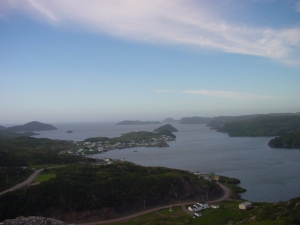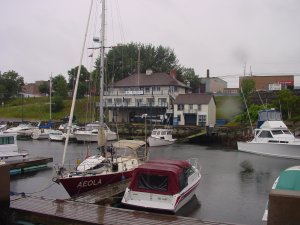News 11
Gaspé to Sydney, Nova Scotia
Gulf of St. Lawrence, Madeleine Islands, Newfoundland, St. Pierre, Sydney, Cape Breton Island
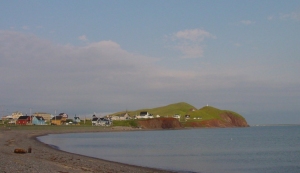
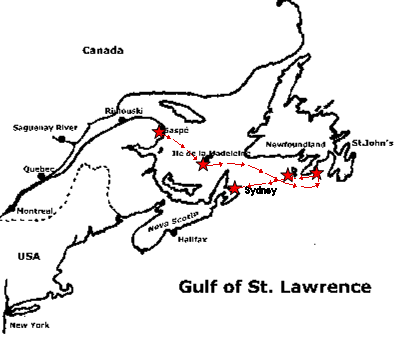
Another chapter in the colonisation of the New World. This time it´s the Acadians, the Basques in search of "blackfish" (i.e. whales), the Scots from the Highlands, after loosing their fiercest battles against the hated Crown, and the Irish plagued by the Big Famine. We´re almost back in the open Atlantic and it´s no childrens playground. The weather becomes unstable, changing from gale to calm within hours and, to add insult to injury, with or without the thickest fog we have ever seen. Patience is the virtue of the day - and a good weather window. The Iles de la Madeleine prove to be a godsent of summer. We fall in love with their golden beaches, dark blue lagoons, mountains and forests so green.The sunsets are of Caribbean quality. Not to mention Celtic music and pubs with an atmosphere we haven´t found since we left Europe.

Most of the year Newfoundland is hard to find - it hides itself in fog. It takes us 54 hours to get there, hard hours in zero visibility and no wind, engine running all the time and us staring at the radar screen. There is a lot of traffic in Cabot Strait, the atlantic entrance to Canada. Big cargoes, ferries, fishermen, whatever you can imagine, from every direction. But they are careful professionals, everybody bypasses us in a wide circle, or as they call it on the busy VHF radio: Everybody gives us a "wide berth". Still, we are not really enthusiastic about navigation with GPS, Radar and nothing else. We wonder how people of preelectronic times fared here, with just deadreckoning and a qualified guess at their hands. In the times of Sail the Outer Banks near Cape Hatteras, the Scilly Isles in England and the coasts of Nova Scotia and Newfoundland were called "The Graveyards of the North Atlantic". We´ve seen all of them by now and, let us tell you, this one is the worst: It only takes a southwesterly gale, putting you on a lee shore, zero visibility due to fog or snow, and , boy, you are lost. Anyway, when unexpectedly we arrive in Placentia Bay, the curtain suddenly lifts, just a bit though, and our guess is getting a little more qualified. The ragged coastline, deep fjords, and zillions of islands are breathtaking and we are able to find our little fishing harbour, St.Lawrence, a bit more easily. We stay there for a few days and then move on to Burin, but that´s another adventure.
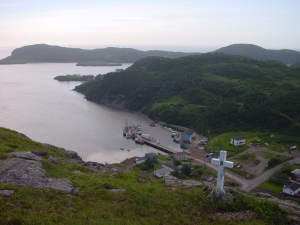
Both harbours are putting us in the middle of friendly and curious fishermen. Contrary to what we are used to in Europe, the reception is open and warm. Their weatherworn faces and callous hands, sometimes missing a few fingers, are telltales of a hard and demanding life. In the village store we buy a book on Newfoundland history, from first settlements in the 16th century until today. Evenings we are sitting in our warm and cosy boat by the golden light of a kerosene lamp, reading. The stories about their seemingly everlasting struggle to survive with all the tributes to poverty and death, an unforgiving sea and their British exploiters are sending shivers down our spines. In the end it all comes down to fish, fish, fish... Well, the fish is almost gone, mostly thanks to European Grand Banks bandits, the government has set quotas, to give the cod populations a break, but is anybody listening....
|
They don´t earn much money, seemingly just enough for survival. The general feeling is, that confederation with Canada, which only dates back to 1948, didn´t really do much more for them than hundreds of years of British arrogance and ignorance. We ask them: "Why are you staying?" "Well, it´s life, just life, and it´s always been like that." and "This is our own world, a very special world, that we want to keep alive. Nobody else understands us anyway." True, it takes a while, till we can guess, what they mean, when they open their mouths and we figure out, they´re talking to us. Considering their normal adversities of everyday life, we seldom met people, who are that cheerful, convivial and self contained. Their laughter is contagious. Our respect for their way of living is growing daily. Noticing, that they understand, how much effort it took us to get here, and their appreciation, are an unexpected surprise.
|
|
|
|
They give us fresh cod for our dinner and take pride in showing us, how skilled and fast they are in filetting it. Best fish we ever had, and nobody wants a dime. Berthing fees are 2 to 5 $Can, there is water and electricity, even showers. Cruising boats from overseas are a rarity and understandably so, weather and coastline are rather difficult. How difficult they are we soon find out as we try to approach a narrow passage between fjords and islands in 20m visibility and a lot of wind, driving us onto all those nice little killer rocks. Still, Burin Harbour is better than anything we have seen in a long time - and historic too. The hill next to the small and protected bay is called "Cooks Lookout", reminding everybody, that the famous explorer of the South Seas started his career as a thorough surveyor of this coastline. - Break: You don´t see any photographs of all these wonderful people on this homepage, because we felt too sensitive about their privacy and we didn´t want to insult or abuse them. We didn´t know how to give back to them a piece of their hospitality, what to offer to them. We promised to come back next year, with a lot more time, and a little more understanding. We considered settling down with them, but for their cruel winter... |
||
 |
 |
Summer is short and long the way to Nova Scotia. Before that serious passage we indulge in a little piece of France, just 30 miles off. The islands of St.Pierre et Miquelon, French Overseas Territory and consequently a piece of Euroland, scarcely populated, they are nothing but a bunch of rugged stone heaps close to the Laurentian Fan, one of those factories, where they make fog. The climate is rough and their charm hard to detect, but they have everything a European sailor would want: cheap wine and brandy, French cheese, almost German bread and a real taste for good cuisine. We fill our bilges and move on after two days, destination Cape Breton Island. |
|
|
|
The trip to Sidney, the only real city of this island, takes us 40 hours. Reeds Nautical Almanac says, this is a region of heavy mining and steel industry, not true, nothing left, just ruins. The town itself has a charme of its own, but a rather melancholy one of better times gone by. The "Loaves and Fishes" near the Anglican Church is rathere busy and there are not many young families on the boardwalk. |
|
Anyway, we´ve seen that before. Upstate New York doesn´t look much different. The Shopping Center is close and The Royal Cape Breton Yacht Club will receive our mail. We can do our laundry and a lot of the usual maintenance work. The weather forecast is terrible anyway (rain no end), so we decide to stay here for a few days. |
|
|
